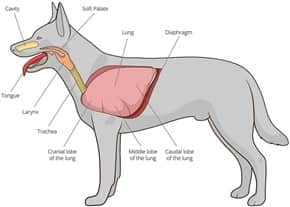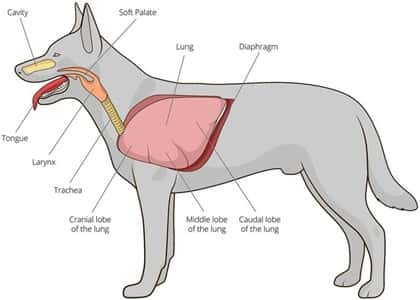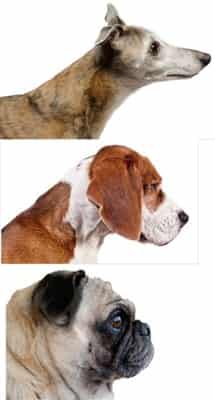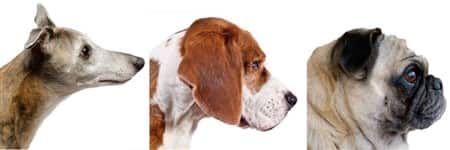Pug Breathing Problems
Why Pugs Have Breathing Problems
A dog's respiratory system consists of the nares (the nostrils), the nasal cavity, the sinuses, the pharynx (the membrane-lined cavity which connects the nose and mouth to the esophagus which is the canal that leads to the stomach), the larynx (also known as the voice box), the trachea (also known as the windpipe), the bronchi (the branches of the trachea that extend into the lungs), and the lungs.
When there is an abnormality of any one of these components, this will affect a dog's ability to breathe properly. Pugs are very prone to respiratory-related abnormalities and this is directly linked to this breed's skull shape.
There are 3 main types of skull and muzzle shapes seen with canines:
Dolichocephalic (image #1) - The skull is thin and rounded and the snout is relatively long. This shape allows for lots of room for the nasal cavities.
Mesaticephalic (image #2) - The skull and snout are each just about equal in length and this is considered to be a ‘medium’ sized muzzle. There is generally adequate room for the nasal cavities and all other components of the upper respiratory system.
Brachycephalic (image #3) - The skull is compact and the muzzle is comparatively short. Because the upper respiratory system must fit into this compressed shape, it is common for there to be abnormalities and related breathing issues.
Clinical Signs of Breathing Issues with Pugs
The most common signs that a Pug is having trouble breathing include:
• Labored breathing when exercising. A Pug may have trouble catching their breath or develop heavy panting with long-duration physical activity, intense activity, and/or when active outside in hot and humid or very cold weather conditions.
• Noisy breathing. A Pug may make lots of noises
including grunting, snorting, gasping, or wheezing even when at rest.
• Snoring. This can vary from minor to severe and may include sleep apnea (short moments when breathing stops).
In some cases, minor breathing issues are considered 'normal' for this breed and no action needs to be taken other than following the general care tips to help Pugs breathe as well as possible (next section). However, in moderate to severe instances, these breathing-related issues point to abnormalities with upper respiratory system components and may warrant veterinary treatment (details ahead).
Top 10 Ways to Help a Pug Breathe Better
Please note: PetPugDog is reader-supported, and some of the product suggestions on this page may be affiliate links. As an Amazon Associate we earn from qualifying purchases. This is at no extra cost to you and helps keep this site running.
Even when a Pug is cleared of breathing-related disorders (stenotic nares, elongated soft palate, tracheal abnormalities, etc.) or a disorder is indeed present but is diagnosed to be minor (no surgery required), a Pug can still have lots of breathing problems.
There may be all kinds of loud noises, trouble falling asleep or staying asleep, heavy panting that interferes with meeting exercise requirements, intolerance for hot or cold weather, and other issues.
Fortunately, there are quite a few things you can do to help your Pug breathe better both when active and at rest.
1. Maintain an indoor room temperature between 68 and 75 Fahrenheit (20 and 24 C).
Use an air conditioner during hot weather and take care to not turn the heat up too much in the winter. For those that do not have an AC, there are some things that can keep a room cooler to help a Pug breathe better including opening windows on opposite sides of the house to create air flow, placing fans to help air circulate throughout the rooms, and keeping blinds and curtains closed to block out sunlight that would otherwise heat up the house.
2. Maintain humidity levels of 35 to 45%.
Overly dry air dries out breathing passages and air with high moisture levels can interfere with breathing as well. Most Pugs do best with humidity levels between 35 and 45% but it is rare for this to be the level naturally found in homes.
In the winter, air is very arid due to cold air not holding moisture. When that dry air is heated in the home, the relative humidity drops significantly, compounding the problem. For this reason, setting up a humidifier like the LEVOIT Cool Mist Humidifier
 can help a Pug breathe better in the wintertime.
can help a Pug breathe better in the wintertime.
In many locales, it's the opposite problem in the summer, when air often holds high levels of moisture. For those that live in an area with high humidity levels, a dehumidifer like the Afloia Dehumidifier for Home
 may be needed.
may be needed.
3. Limit exposure to very cold air.
Air that is inhaled through the nasal passages is warmed before it reaches the lungs, but air that is inhaled through the mouth is not and that cold air can exacerbate breathing problems. So, if a Pug is outside in the winter and is breathing through their mouth (often seen with Pugs that have stenotic nares, a very common issue with this breed), that dog may pant heavy, gasp for breath, and struggle to keep breathing under control.
This is seen most often on days that are under 10 F (-12 C) but can occur at higher temps in the 20's or 30's. If your Pug has more trouble in the winter, limit outdoor time just to bathroom trips and short walks to maintain exercise requirements.
4. Take exercise precautions during hot, humid weather.
It's a fine line between not pushing a Pug too far and making sure that there is enough physical activity to stay healthy. Since summer can be long and Pugs should not stay sedentary, exercise may need to be limited to early mornings and later in the evenings to avoid the hottest parts of the day, breaks should be taken in the shade, and plenty of water should be provided. If there is a heat wave, keep your Pug indoors.
5. Never place a collar on your Pug when on leash.
When a leash is connected to a collar, any and all stress or tension from that leash is placed directly against the windpipe which can severely impede breathing ability. Panting, wheezing, exercise intolerance, and many more aspects can dramatically worsen.
Pugs and other brachycephalic breeds should always wear a harness instead; this distributes pressure across the back, chest, and shoulders while keeping the neck free. If you're looking for a great harness for your Pug puppy or dog, the Puppia Soft B Harness Vest
 is excellent. This is a step-in design (nothing has to be fit over the head), it's made of breathable air-mesh, and it is adjustable.
is excellent. This is a step-in design (nothing has to be fit over the head), it's made of breathable air-mesh, and it is adjustable.
6. Limit over-excitement.
When Pugs get too excited this can lead to excessive panting and can worsen clinical symptoms of stenotic nares, elongated palate, and other breathing-related disorders. Offer introductions to new people or other dogs in a gradual and casual manner and keep things low-key when offering new toys or announcing a fun activity.
7. Keep your Pug at a healthy weight.
Excess weight affects breathing by pushing on the diaphragm and chest wall, adding pressure to the tracheal area, decreasing the amount of room for the lungs, and causing the heart and lungs to work harder to move oxygen around.
Since Pugs are prone to becoming overweight, it's vital to keep an eye on this. Keep your Pug on a healthy high-quality diet
and maintain a regular exercise schedule.
8. Reduce or eliminate air irritants.
Environmental allergens like pollen, weeds, grasses, and mold and certain air pollutants like cigarette smoke, air freshener sprays, and aerosol cleaners can all exacerbate breathing problems with increased nasal congestion, chest congestion, coughing, wheezing, and/or labored or shallow breathing.
Eliminate what you can by making your home a non-smoking zone and avoiding aerosol products. If your Pug has allergies, working to resolve this may include limiting time outside on high-pollen days, wet-dusting and vacuuming the house often, and cleaning off the coat and paws when coming back inside.
For all airborne irritants, running a central air unit with HEPA filters or using a free-standing air purifier like the
LEVOIT Home Air Purifier with True HEPA Filter
 can be very beneficial.
can be very beneficial.
9. Encourage good sleeping positions.
If the head is tucked down and the neck is scrunched or a Pug sleeps in an otherwise awkward position, this can cause compression of the airway passages; there may be increased snoring and/or excessive loud breathing. Sleep apnea, episodes of greatly reduced or paused breathing, can also be at play which can be a dangerous and sometimes fatal condition.
To help a Pug breathe easier at night, the body should be in a stretched-out arc with the neck supported and extended. To facilitate this, have your Pug rest and sleep on a large round or rectangle dog bed with raised bolstered sides that serve as a pillow for the head. Since this breed is very prone to hip issues, a memory foam mattress is recommended. A bed like the JOYELF Memory Foam Dog Bed
 meets all of these requirements.
meets all of these requirements.
If your Pug likes to sleep on a flat mattress, try slipping a narrow pillow under their head.
10. Monitor your Pug.
With so many factors that can affect how well a Pug breaths there can be changes throughout the year and over time. So, continually monitor your Pug for increased breathing problems, making adjustments as needed. If there is a dramatic change in breathing issues, sudden episodes of respiratory distress, or chronic breathing problems that do not respond to the changes that you make, bring this to the attention of the veterinarian asap.
Health Conditions that Affect a Pug's Ability to Breathe Well
As covered earlier, the Pug's brachycephalic profile makes this breed prone to certain abnormalities associated with the upper respiratory system. Let's take a look at these.
Stenotic nares
Also known as pinched nostrils, this is a common issue, present to some degree with approximately 50% of Pugs. Signs of this include noisy breathing (especially when inhaling), noticeable flaring of the nostrils when inhaling, snoring, and exercise intolerance. With severe cases, there may be cyanosis (gums turn blue) and/or fainting. Moderate to severe cases are corrected with a relatively simple surgical procedure. Read more about Pug Dog Stenotic Nares.
Elongated Soft Palate
This involves the soft palate, which is located at the back of the throat, partially blocking the entrance to the trachea, making it difficult to breathe well. Signs include newborn pups dribbling milk from the nose, heavy panting, gagging on or regurgitating food, noisy breathing, snoring, exercise intolerance, and/or excessive drooling. With severe cases, there may be cyanosis (gums turn blue) and/or fainting. Read more about Pug Dog Elongated Soft Palate.
Tracheal Issues
This includes hypoplastic trachea, an abnormality with the rings of cartilage that surrounds the windpipe and collapsed trachea which is a degeneration or weakening of the rings that leads to collapse. Signs include a distinctive honking-type cough, noisy breathing, gagging on or regurgitating food, gasping for air, and exercise intolerance. With severe cases, there may be cyanosis (gums turn blue) and/or fainting. Read more about Pug Dog Tracheal Issues.
Everted Laryngeal Saccules
This involves the laryngeal saccules, which are located above the vocal cords, becoming everted (flipping inside out) and partially blocking the entrance to the trachea, making it difficult to breathe well. It is considered the first stage of laryngeal collapse, a very serious and often fatal condition, so early diagnosis and treatment is vital. Read more about Pug Dog Everted Laryngeal Saccules.
Did you find this to be helpful?
If so, you'll want to check out our book, PetPugDog's GIANT Book of Pug Care. This comprehensive care book is a complete guide for every step of your Pug's life. See what's inside.
You may also like these helpful articles:
Pug Separation Anxiety
- Excellent tips and step-by-step advice for helping a Pug that hates to stay home alone.
Pug Grooming
- A super-helpful round-up of all the grooming tasks you should be doing to keep your Pug clean and smelling nice, and to maintain healthy skin and fur.
Pug Care Tips
- These are the 15 things that will keep a Pug happy, safe, comfortable, and healthy. See how many are you currently doing and which ones should you start to implement today.





